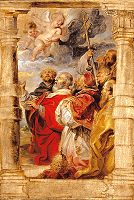 |
The Ecclesiastical Hierarchy in Adoration
Peter Paul Rubens. Ca. 1625 Oil on panel, 67 x 47 cm The Speed Art Museum, Louisville, Kentucky Between a pair of rusticated Tuscan columns, a group of ecclesiastical dignitaries kneels and stands in adoration of the Eucharist. At the far right is a bishop, wearing a richly embroidered cope; immediately to the left is a pope, his papal tiara resting on the ground before him. Beyond him is a cardinal, clasping his tasseled hat, and a Dominican monk, his hands upraised in prayer. Standing behind these figures are a man holding the triple-cross staff of the papacy, another with a crozier, and a third figure of whom only the head can be seen. All of the figures look to the sky, where two putti hover in the clouds and gesture toward the left. |
The putti in the Ecclesiastical Hierarchy direct the figures' gaze toward the scene at upper center of the 5 tapestries ensemble, where two cherubs bear a monstrance that contains the consecrated Host and emits a brilliant light. As a whole, the scenes in the composite sketch depict the adoration of this instrument of the Eucharist by the entire fellowship of the Church, including an upper tier of music-making angels and earthly dignitaries from the secular and ecclesiastic realms.
While the companion scene of The Secular Hierarchy in Adoration, which appears at the lower left in the Chicago sketch, features identifiable likenesses of members of the ruling Spanish and Austrian houses of the Hapsburg dynasty, Rubens probably did not intend to portray specific individuals in this sketch. Rather, the generic personalities embody different degrees and branches of the ecclesiastical hierarchy, united in worshiping the sacrament.
The large cartoon from which the tapestry was woven has not survived, but the tapestry woven in Brussels by Jacob Geubels shows only minor differences from the modello. 17